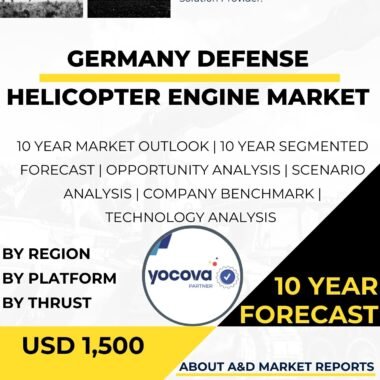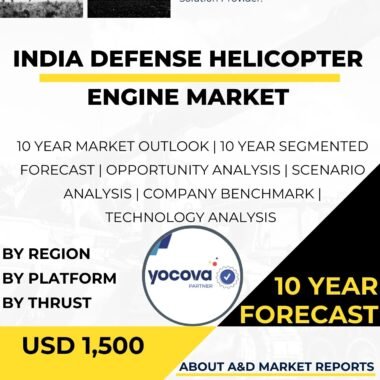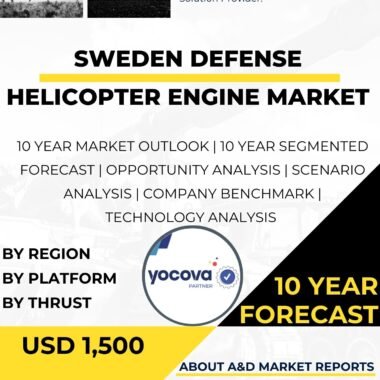Description
The China defense turbojet engine market has witnessed significant growth and development in recent years. Turbojet engines play a crucial role in the propulsion of military aircraft, providing high-speed capabilities and maneuverability for various defense applications. This market analysis provides an overview of the China defense turbojet engine market, including key players, market drivers, challenges, and future prospects.
The China defense turbojet engine market is characterized by the presence of both domestic and international players. These companies have invested in research and development to enhance the performance and capabilities of their engines to meet the specific requirements of the Chinese military.
International players, including renowned engine manufacturers such as Pratt & Whitney, General Electric (GE), and Rolls-Royce, have also established collaborations and partnerships in China. These collaborations have facilitated technology transfer, knowledge exchange, and joint development programs, contributing to the advancement of turbojet engine capabilities in China.
Firstly, China’s focus on military modernization and the enhancement of its air force capabilities has been a primary driver. Turbojet engines provide high-speed capabilities and maneuverability, enabling aircraft to perform various defense applications, including air superiority, strike missions, and reconnaissance. As China aims to develop a more advanced and capable military, the demand for advanced turbojet engines has grown.
Secondly, the need to improve operational capabilities and maintain a competitive edge has fueled the demand for turbojet engines in China. Modern turbojet engines offer higher thrust, better fuel efficiency, and improved reliability, enabling aircraft to operate effectively in demanding environments and perform a wide range of missions. By developing advanced turbojet engines, China can enhance its operational capabilities and maintain a technologically advanced air force.
Technological advancements have played a crucial role in the growth of the China defense turbojet engine market. Domestic companies have focused on developing indigenous engine solutions with advanced features and capabilities. China has made significant progress in the development of various types of turbojet engines, including afterburning turbojet engines and low-bypass turbofan engines.
China has successfully developed and deployed advanced turbojet engines, such as the AECC WS-10 turbofan engine, which powers the Chinese J-11 and J-10 fighter aircraft. The development of afterburning turbojet engines, such as the AVIC WP-13B, has improved China’s capabilities in high-speed, high-altitude applications. Additionally, research and development efforts are ongoing in the field of advanced low-bypass turbofan engines, which offer improved fuel efficiency and performance for future aircraft platforms.
Another driver of the China defense turbojet engine market is the civilian sector, including applications in fields such as commercial aviation and research. Turbojet engine technology can be repurposed for civilian use, providing opportunities for dual-use applications. China’s growing aviation industry and the need for enhanced civilian aircraft capabilities have created a demand for turbojet engines in non-military applications. The development of engines for civilian use provides opportunities for technology transfer, commercialization, and the growth of the market in China.
However, the China defense turbojet engine market also faces certain challenges. One of the primary challenges is the need for continuous investment in research and development to stay ahead of evolving technologies, emerging requirements, and changing operational environments. As adversaries develop more advanced aircraft technologies and seek to neutralize air superiority, China must invest in innovation and advanced technologies to maintain its turbojet engine capabilities.
Additionally, the market faces challenges related to international export restrictions and intellectual property rights. The development and export of turbojet engines are subject to strict regulations due to security concerns and the protection of sensitive technologies. This can limit market opportunities and hinder collaboration with international partners.
Looking ahead, the future prospects for the China defense turbojet engine market are promising. China’s commitment to military modernization, operational effectiveness, and technological advancement will continue to drive investments in turbojet engines. Ongoing research and development efforts, collaborations between domestic companies and international partners, and the integration of emerging technologies, such as improved materials, advanced fuel systems, and enhanced control systems, are expected to result in the introduction of more advanced and capable turbojet engines.
The integration of advanced technologies, such as digital engine control systems, health and usage monitoring systems (HUMS), and advanced materials, may shape the future of the market. These technologies can improve engine performance, increase fuel efficiency, enhance reliability and maintenance capabilities, and improve overall operational effectiveness. The development of intelligent engine systems, which leverage advanced algorithms and data analytics, can further enhance the capabilities and flexibility of turbojet engines.
In conclusion, the China defense turbojet engine market has witnessed significant growth driven by the country’s focus on military modernization, operational effectiveness, and technological advancement. Technological advancements, collaborations between domestic and international players, and the government’s commitment to indigenous defense capabilities have contributed to the development and deployment of advanced turbojet engines. Challenges related to evolving technologies, export restrictions, and intellectual property rights need to be addressed. With ongoing research and development, collaborations, and the integration of emerging technologies, the future of the China defense turbojet engine market looks promising, with opportunities for further growth, innovation, and advancements in engine capabilities.




